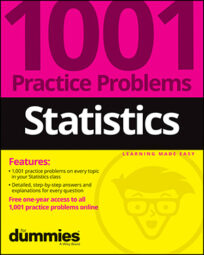Solving statistics problems is always about having a strategy. You can't just read a problem over and over and expect to come up with an answer — all you'll get is anxiety! Although not all strategies work for everyone, here's a three-step strategy that has proven its worth:
Label everything the problem gives you.
For example, if the problem says "X has a normal distribution with a mean of 10 and a standard deviation of 2," leap into action: Circle the 10 and write μ, and circle the 2 and write σ. That way you don't have to hunt later to find the numbers you need.
Write down what you're asked to find in a statistical manner.
Hint: Questions typically tell you what they want in the last line of the problem. For example, if you're asked to find the probability that more than 10 people come to the party, write "Find P(X > 10)."
Use a formula, a process, or an example you've seen to connect what you're asked to find with what the problem gives you.
For example, suppose you're told that X has a normal distribution with a mean of 80 and a standard deviation of 5, and you want the probability that X is less than 90. Label what you're given: "X normal with μ = 80 and σ = 5." Next, write what you need to find, using symbols: "Find P(X < 90)." Because X has a normal distribution and you want a probability, the connection is the Z-formula: Z = (X – μ)/σ. You have a good idea that this is the right formula because it includes everything you have: μ, σ, and the value of X (which is 90). Find P(X < 90) = P[Z < (90 – 80)/5] = P(Z < 2) = 0.9772. Voilà!

